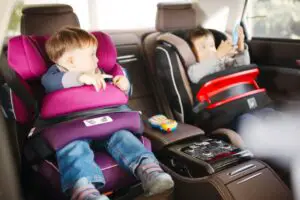Car seats for babies and children are known to be lifesavers. During a collision or a sudden stop, a kid not seated in a car seat might be seriously wounded or killed.
It even occurs at slow paces. Ensure that your child is safely fastened into a car seat for every trip in the automobile.
Car seat laws in Nevada say that all types of car seats save the lives of children if they are used according to the age, height as well as the weight of the child.
According to the law, a child under the age of 4 must ride on a rear-facing car seat until he/she outgrows.
They can then shift to a forward facing seat and sit until the age of 7 and then finally move to a booster car seat until the age of 12 or more spending in the seat requirements.
In this post, I will be discussing all the requirements of car seats in detail, so it will be sufficient for you to read the entire article.
This will save your child’s life, and if you pass the advice along to others, it will also benefit them.
Table of Contents
- 1 Nevada Car Seat Requirements By Ages
- 2 Car Seat Weight And Height Requirements In Nevada
- 3 Type Of Car Seat Laws In Nevada
- 4 When Is The Time For My Child To Sit In The Front Seat In Nevada?
- 5 What Happens If You Leave Your Child In A Car In Nevada?
- 6 Taxi Car Seat Laws In Nevada
- 7 Nevada Law Regarding Car Seats In Accidents
- 8 Uber Car Seat Laws In Nevada
- 9 Conclusion
Nevada Car Seat Requirements By Ages

I will start this article by showcasing the car seat requirements that every parent must meet before putting them on one.
The rules typically mention the age limit, but it is worth noting that height and weight are also important factors.
You must not ignore them and do not try to transition your children early at all, as that can put their lives in danger.
1 Year Old
Some kids at one age ride on an infant-only car seat, but this depends on their physical growth.
If the child is growing fast and is over 20 pounds, he/she should ride on a rear-facing car seat.
2 Year Old
Children aged two can move to a 3-in-1 convertible car seat. However, it should be placed in a rear-facing position only.
The main reason you should move your child on this is that the height and weight limits are increased so the child can sit for a longer period.
3 Year Old
As mentioned above, the 3-in-1 convertible car seat can hold the child on the seat for a long time which means he/she can ride at the age of 3.
You cannot transition to another seat unless your child outgrows this one.
4 Year Old
A forward-facing car seat with a harness will be required once the child is four years old. This is usually for children over 40 pounds and a height of more than 5 inches.
Current rear-facing car seats can hold up to 40 pounds so make sure to check before moving to forward-facing.
5 Year Old
Forward-facing car seats usually hold a weight of fewer than 50 pounds. If your five-year-old child is less than that, he/she can ride easily and comfortably.
6 Year Old
Even at six, the child must be riding in the vehicle on a forward-facing car seat. However, check the manufacturer’s car seat limits to be certain.
7 – 9 Year Old
According to the law, the forward-facing car seat is allowed only until 7. You most probably have to move the child to a bigger booster seat with a bigger height and weight limit.
10 Year Old
At age 10, many parents make the mistake of putting their children on seat belts, which can be quite dangerous.
According to Nevada law, a child should be on a booster seat at ten and up until he/she is 12 years old.
Plus, the transition to seat belts can only be done when the child exceeds the car seat laws.
Car Seat Weight And Height Requirements In Nevada

According to the law in Nevada, rear-facing car seats allow kids up to 40 pounds.
Remember that the height limits may vary slightly, so it is advised to check the car seat manufacturer’s instructions.
Forward-facing car seats, on the other hand, have different requirements.
The child must be over 40 pounds, but less than 57 pounds and must also be less than 6 inches to ride on the seat.
Moreover, when children are over 50 pounds but less than 60 pounds and their height is also around 4’9 inches, they should ride on a booster seat before slowly moving to seat belts.
Type Of Car Seat Laws In Nevada
You presumably understand by now that three leading car seats are safeguarding the lives of children.
This section will assist you in understanding better about all of them so keep on reading.
1. Rear Facing Car Seat
Parents should start with the rear-facing car seat. This comes in an infant-only or 3-in-1 type, so you can decide based on your child’s age, height, and weight.
2. Forward Facing Car Seat
Next comes the forward-facing car seat, which parent’s transition to when their child officially outgrows the weight and height limit. Mainly ages of 4 until seven are allowed on it.
3. Booster Seat
Lastly, you will need a booster car seat with more height and weight capacity so the child can be comfortable and have space to move around.
This seat is important before you transition the child to a seat belt.
When Is The Time For My Child To Sit In The Front Seat In Nevada?
In Nevada, there is no set age limit for children to ride in the front seat.
The Nevada Department of Motor Vehicles, on the other hand, suggests that kids ride in the back seat until they are at least twelve years old.
Additionally, children should utilize a booster car seat until the car seat belt can be adjusted to correctly suit the thighs rather than the stomach.
In Nevada, the law permits the vehicle driver to choose when a kid should ride in the front seat.
What Happens If You Leave Your Child In A Car In Nevada?
You cannot leave your child alone in the car in Nevada. It is known to be illegal in that state. This is also a misdemeanor that can cost you a lot of money.
You can either end up with fines up to $1000 or end up serving jail time up to six months or so.
However, this depends on how serious the situation was when you left your child in the vehicle alone.
Taxi Car Seat Laws In Nevada
It is said that the car seat guidelines in Nevada do not apply to any transportation services and taxis are one of them. In Nevada, you do not need a car seat to ride in a taxi.
However, following the rules of car seats and taking the seat with you would not be a problem. After all, it is all for the safety of your child.
Nevada Law Regarding Car Seats In Accidents
If the car seat has been involved in an accident, the best you can do as a parent is to replace it immediately, even if you do not see any apparent destruction.
You can also get it examined at the Department of Transportation just to clarify what to do. But the best advice would be to replace it.
Uber Car Seat Laws In Nevada
There are no clear laws regarding the requirements of car seats in Uber.
However, since it is not needed in public transportation, Uber is also one of them, which means you are exempt from using a car seat.
But it does not mean you cannot take it with you. Just inform the Uber driver beforehand so that it is not an issue.
Conclusion
Nevada car seat laws are much tougher now than they were before, which gives you more reason to learn about them and follow them.
If a driver fails to do so, he/she has no choice but to pay fines of around $1000 or more, relying on the gravity of the problem.
However, remember that following the rules is much easier than serving time in jail.
After all, you will be keeping your little ones safe and comfortable and get to have a wonderful and peaceful journey all the time.

I am Tahir Azam, and I have been writing amazing articles for TaxiHack for as long as I can remember. I know everything that is to know when it comes to automobiles and is always on top of industry news and developments. While I am not an expert by any means, I pride myself on knowing the ins and outs of many different problems and, of course, their solutions. The articles on our website are some of the best and well-researched content that you will find, and I spend countless hours making sure this remains to be true. This is why I ask you to take your time out and read some of my articles, especially if you find a topic that resonates with you or is something you are looking into. This way, you will find the perfect mix of information and tips on your desired topic. Learn more about Tahir.



